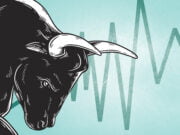Futures were little changed overnight as Wall Street gears up for the start of Q2 earnings season. JPMorgan Chase (JPM) will unofficially kick things off before the bell with other major financial firms to follow in the coming days. Wall Street’s expectations are high, find out what they’ll be looking for in the full article.
Plus, Investors will be looking at key evidence of inflation this morning with the release of June’s Consumer Price Index. This morning, we’ll discuss what economists and the Fed may be looking for today, and in the coming days as a raft of pivotal metrics will come to the surface.
According to experts, it is perhaps more evident now that inflation is looming than ever before. Workers’ wages may also be at stake, which means big changes may be on the horizon for many Americans. We’ve got the details on all of this and more in this morning’s morning briefing.
Stocks are mixed ahead of the anticipation of big bank earnings starting today…
A lot of major money players are reporting their quarterly earnings this week. Goldman Sachs (GS) and JPMorgan Chase (JPM) will report today, while Bank of America (BAC), Wells Fargo (WFC), and Citigroup (C) will report on Wednesday. Morgan Stanley (MS) will release earnings on Thursday.
Today, Goldman Sachs (GS) is the major bank that earns the most money from Wall Street trading and activity. As a result, the company’s business may have been affected by the weaker market climate in Q2. Remember how GS outperformed analysts’ estimates in the first quarter? The trading industry hummed along, while investment banking—another large area for GS—brought up solid profits.
Even though year-over-year earnings are projected to be robust, slower trading activity and a drop in SPAC business may impact in Q2. Goldman Sachs CEO David Solomon cautioned during the company’s Q4 results conference in January that the surge in SPAC (Special Purpose Acquisition Company) equity issuance isn’t sustainable.
Here’s what to look for this week in economic data…
Retail sales data, for better or worse, may have a significant influence on trade since they reveal how consumers feel about discretionary purchases. When people buy more goods they don’t need, it might indicate that they’re optimistic about their job prospects and the economy in general. Retail sales are anticipated to fall 0.6% in June, which would be an improvement from the 1.3% decrease the previous month.
Meanwhile, the CPI is anticipated to rise to 86.3 from 85.5 in the previous month. While the Fed’s Beige Book lacks a numerical value, it does include tales from around the country about what individuals are thinking about business conditions, which can provide a useful qualitative assessment. Outside of the banking industry, PepsiCo (PEP) and Delta Air Lines (DAL) are two high-profile corporations that are exposing their books.
Also starting today, a slew of economic statistics will be released to assist in explaining the progress achieved over the last three months, including June’s CPI and PPI (Producer Price Index) reports, July Empire State and Philly Fed surveys, and, of course, weekly unemployment claims. New Retail Sales, Import/Export statistics, and Industrial Production/Capacity Utilization figures will also be released for June.
Inflation expectations have risen to a new high, according to the New York Fed Poll. Wages may rise as well…
According to a poll released Monday by the Federal Reserve’s New York district, despite the central bank’s guarantee that present inflation pressures will not continue, consumers have a different opinion. According to the June Survey of Consumer Estimates, median inflation expectations for the next 12 months increased to 4.8%, up 0.8% from May and the highest level in the series’ history. While the three-year forecast stayed steady at 3.6%, it is still considerably over the 2% threshold that the Fed considers healthy for a thriving economy.
Over the last few months, Americans have seen some astronomical price increases. Shortages and supply chain difficulties throughout the world have driven up the cost of producing and transporting products, forcing consumers to foot the bill. Prices for certain basic essentials, like lumber, have remained stable since then. However, even when the economy returns to a more normal state, inflation continues to rise at an alarming rate.
It’s a significant shift from the pre-pandemic situation and another illustration of how the coronavirus epidemic is changing the economy and everyday life. Prior to the epidemic, inflation had been mired at rock bottom for years, with the Federal Reserve aiming for a rate of roughly 2%. The Fed now has an increasingly difficult task of balancing the need to assist the economy with enough stimulus while keeping inflation under control. The goods that are pushing inflation up are shifting as the economy gains traction. People are spending more money dining out now that the pandemic restrictions have been relaxed, and the return to work has prompted a work wardrobe update.
Mark Hamrick, the Senior Economic Analyst at Bankrate.com, said that “One of the major challenges for employers, along with finding workers, is to retain their current employees and one way to do that is to offer current employees a new opportunity and increased pay.” He went on to state that, “In the power struggle between workers and employers, the balance has shifted in workers’ favor.” Employees have already seen an increase in their salary for June. According to the Labor Department, average hourly wages increased 0.3% month over month and 3.6% year over year as of the most recent figure.















